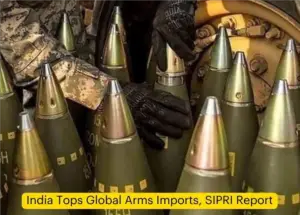
Why in news?
- India’s defense sector stands at a critical juncture, characterized by a significant surge in arms imports, coupled with ambitious indigenous initiatives aimed at reducing reliance on foreign weaponry.
- Recent data from the Stockholm International Peace Research Institute (SIPRI) sheds light on India’s evolving arms import dynamics, while government initiatives underscore a concerted push towards self-reliance and innovation in defense manufacturing.
India’s Arms Import Dynamics:
- According to SIPRI data, India emerged as the world’s leading arms importer during the period from 2019 to 2023, with a notable increase of 4.7% compared to the previous five-year period. Despite historical ties with Russia, India is diversifying its arms procurement by increasingly turning to Western countries like France and the USA. This shift reflects a strategic move towards enhancing defense capabilities through diverse procurement channels.
SIPRI Insights and Global Arms Trade:
- SIPRI’s data also highlights broader trends in the global arms trade, with Asia and the Middle East dominating arms imports.
- Notably, Ukraine’s emergence as the fourth-largest arms importer underscores evolving geopolitical dynamics.
- Conversely, the United States and France have solidified their positions as leading arms exporters, with Europe maintaining a significant share of global arms exports.
Government Initiatives Towards Self-Reliance:
- In response to the escalating arms imports, the Indian government has initiated several measures to bolster indigenous defense capabilities.
- Notable among these is the allocation of ₹6.2 lakh crore in the Interim Budget 2024-25, with a focus on capital expenditure for new procurements.
- Additionally, initiatives such as Positive Indigenisation Lists, increased FDI limits, and the establishment of Defence Industrial Corridors aim to catalyze domestic defense manufacturing.
Positive Indigenisation Lists and FDI Reforms:
- The Positive Indigenisation Lists identify specific components and subsystems for domestic manufacturing, providing a roadmap for indigenisation efforts.
- Concurrently, the increase in FDI limits to 74% and the streamlining of approval processes seek to attract foreign investment and foster collaboration in defense production.
Defense Industrial Corridors:
- The establishment of Defence Industrial Corridors in Uttar Pradesh and Tamil Nadu aims to create hubs for defense manufacturing, leveraging regional strengths and fostering collaboration between industry and academia.
- These corridors offer a conducive ecosystem for innovation and technology development, driving India’s quest for self-reliance in defense.
iDEX and SRIJAN:
- Initiatives like Innovations for Defence Excellence (iDEX) and the SRIJAN portal further bolster India’s indigenous defense capabilities.
- iDEX fosters innovation and collaboration among various stakeholders, while SRIJAN serves as a platform for vendors to participate in the indigenisation of defense equipment previously imported, facilitating a seamless transition towards domestic production.
Conclusion:
- India’s journey towards self-reliance in defense manufacturing is marked by both challenges and opportunities. While the surge in arms imports underscores immediate procurement needs, indigenous initiatives signal a strategic shift towards building a robust defense industrial base.
- As India navigates these dynamics, collaboration, innovation, and strategic investments will be key to realizing its vision of a self-reliant and technologically advanced defense ecosystem.
People also ask
Q1: What is SIPRI and why is its data significant in the context of India’s defense sector?
Ans: SIPRI, the Stockholm International Peace Research Institute, is an independent international institute that provides data, analysis, and recommendations on conflict, armaments, arms control, and disarmament. Its data on arms transfers offers insights into global defense trends and India’s position within the international arms trade.
Q2: Why has India emerged as the world’s leading arms import according to SIPRI?
Ans: India’s status as the leading arms importer reflects its efforts to modernize its armed forces and address security challenges. The country’s large defense budget, coupled with diverse security concerns, drives substantial procurement of defense equipment and technology from various sources.
Q3: How has India’s arms import profile evolved over time, particularly in terms of suppliers?
Ans: Historically, Russia has been India’s primary arms supplier. However, recent data indicates a diversification of procurement sources, with India increasingly turning to Western countries like France and the USA. This shift signifies a strategic effort to balance defense ties and leverage technology from multiple partners.